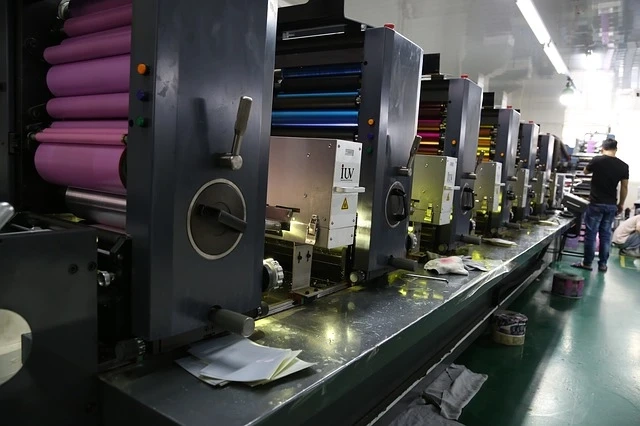More and more entrepreneurs have opted for inkjet printing, a greener and more efficient alternative to the classic one with a master image carrier. Regardless of the substrate, the technology allows you to create high-quality and durable things. Still, for printers, it promises a long way associated with ink preparation. What colored fluids are used, why not every textile can withstand the reactive components of them, and how piezoelectric printing conquers the world read in this article.
For the excellent spreading of the ink droplet onto the substrate, good wetting behavior or low contact angle is necessary. The material\'s porosity, thermal conductivity, and temperature determine the morphology of the resulting printed elements. For inkjet technology, fairly liquid-colored fluids include several solvent systems with different boiling points. That allows you to reduce the coffee ring effect when the drop hits the material.
Modern inkjet printing is one of the 2021 trends in print on demand in the industry. This rapidly developing technology conquers the world with prospects: it’s profitable, low-toxic, and doesn’t require colossal labor costs. Controlling the shape and quantity of ink release ensures that all the brilliance of digital designs is accurately reproduced. The editorial staff of Multi-Programming Solutions dealt with the details.
POD: Printing on everything
Industrial inkjet printing is based on a range of materials that differ in nature, structure, and properties. For example, the ordinary substrates are plastic, paper, cardboard, and textiles.
Depending on the stiffness, they’re classified as flexible, semi-rigid, rigid. The first one includes materials (e.g., films or laminates) with a thickness of up to 25 µm, the latter - about 150 μm. Plastic bottles, boxes, containers, plates, etc., are often made from rigid substrates. But if your brand is focused on sustainability, you need to be picky about your choice of materials. There are alternative biodegradable plastics such as polylactide, cellulose, and starch-based products.
It’s often difficult for an entrepreneur to keep track of the variety of work processes. For example, finding a supplier who offers organic ink can sometimes take a long time: you communicate, find the best price, make compromises to maintain valuable cooperation, etc. But you can automate many operational tasks using PodZa, one of the best print on demand services. Add functionality at your discretion, contact the 24/7 support service, delegate tasks - why make your life complicated?
Most films require surface treatment before drop-on-demand microdroplet printing as follows:
- corona discharge in the air;
- UV radiation;
- flame activation;
- hydrolysis;
- photochemical bud;
- application of reactive gases, etc.
Semi-rigid and rigid plastic sheets are manufactured by an extrusion process using a slit nozzle. For drop-on-demand technology, commercially available are A-PET / PE, PVC / PE, PP / EVOH, PP, PE. Such pre-activated materials can undergo printing after formation, although the dominant method of decorating is labeling.
Synthetic pages and polymer-coated boards are made from polyolefin (PP or PE) and have excellent resistance to tearing, the impact of UV radiation, chemicals, water, etc. For example, cartoons with polymer surfaces have different functional properties. They’re often used for POD inkjet printing on polymer cards, book covers, product labels, packaging.
In our guide on how to start a POD business, the idea of a niche was described, starting from which you can successfully sell several products for a narrow segment of the audience. Beverage bottles, caps, covers, containers, etc., are made from the above materials. They’re often decorated by in-mold labeling using thermophilic printing and polymer inks. Read on for more details.
Polymers and polymer inks
While pigments and dyes bring color to the printing ink, resins and polymers hold them as a buffer. They contribute to the flexibility, gloss, and adhesion of the formulation.
Cellulose, rubber, starch, shellac, and natural resins such as vegetable oils or rosin acids from wood are natural polymers and are often pre-modified before use. For example, the nitration reaction allows the synthesis of nitrocellulose, an excellent film-forming resin for packaging inks.
Synthetic variants are based on petroleum chemistry and are formed by a polymerization reaction, ranging from 15,000 to 200,000. Their solution polymers such as polystyrene, polyacrylamide, and polyethylene oxide are utilized in fluid formulations to grind and disperse pigments. They control resolubility on the press and color stability. For example, in drop-on-demand inkjet printing of SU8 polymer, the ink has an extremely high viscosity, chemical inertness, and elasticity. The high viscosity of this non-Newtonian fluid is changed with the applied shear stress. Drop-on-demand inkjet printing of SU8 polymeric sand is computer-controlled and depends on different parameters of piezo-actuated printer head: pulse amplitude and length, temperature, nozzle diameter, etc. The droplet diameter increases on non-treated silicon and decreases on a surface terminated by a silane-based self-assembled monolayer.
Drop-on-demand inkjet printing of SU8 polymer clay is increasingly considered a cost-effective and flexible method. Rapid prototyping capability, high precision dispensing, non-contact material deposition, and low waste are the key benefits of such technology...


